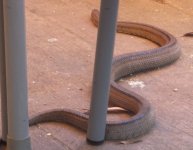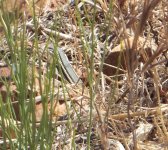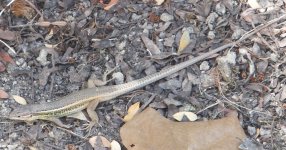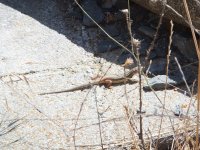Sangahyando
Well-known member

These reptiles were seen in Extremadura earlier this month.
#1 Rhinechis scalaris?
This snake was mid-sized (>50 cm long) and rather aggressive, due to its predicament (accidentally finding itself in the middle of a busy place and being driven into the bushes). One of the locals identified it as an adult Ladder Snake (Rhinechis scalaris). Is that correct? As far as I can tell, this seems plausible because of the two conspicuous lines along the back, and the apparent darker dot on the cheek, but I'm not very experienced with herp identification, so I'd welcome other people's input.
#2 Psammodromus [algirus] manuelae or Psammodromus hispanicus?
This was one of the many (putative) sand racers I encountered in the region.
If it is the former, does that species have an English name?
#3, #4 Psammodromus [algirus] manuelae or Psammodromus hispanicus?
Other examples. There was one recurring type that I dubbed "Rock Bunting Lizard" because of its typical pattern of grey and black stripes on its head and upper body combined with a rusty-coloured hip region.
#5 (no picture) Snake sp.
We came across another snake, which I unfortunately didn't manage to photograph, that was mid-sized, fairly slender, and appeared green without visible markings. It was moving quickly across the road. The surrounding habitat was steppe with occasional patches of scrub or trees.
As always, any ideas welcome.
Regards, A
#1 Rhinechis scalaris?
This snake was mid-sized (>50 cm long) and rather aggressive, due to its predicament (accidentally finding itself in the middle of a busy place and being driven into the bushes). One of the locals identified it as an adult Ladder Snake (Rhinechis scalaris). Is that correct? As far as I can tell, this seems plausible because of the two conspicuous lines along the back, and the apparent darker dot on the cheek, but I'm not very experienced with herp identification, so I'd welcome other people's input.
#2 Psammodromus [algirus] manuelae or Psammodromus hispanicus?
This was one of the many (putative) sand racers I encountered in the region.
If it is the former, does that species have an English name?
#3, #4 Psammodromus [algirus] manuelae or Psammodromus hispanicus?
Other examples. There was one recurring type that I dubbed "Rock Bunting Lizard" because of its typical pattern of grey and black stripes on its head and upper body combined with a rusty-coloured hip region.
#5 (no picture) Snake sp.
We came across another snake, which I unfortunately didn't manage to photograph, that was mid-sized, fairly slender, and appeared green without visible markings. It was moving quickly across the road. The surrounding habitat was steppe with occasional patches of scrub or trees.
As always, any ideas welcome.
Regards, A








